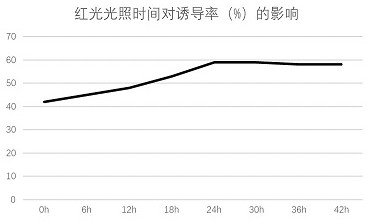Method for establishing Caihong populus regeneration system by taking petioles as explants
A technology of explants and poplar, applied in plant regeneration, botanical equipment and methods, horticultural methods, etc., can solve problems such as high differentiation rate, low pollution rate, and difficulty in establishing the first generation of sterile lines
- Summary
- Abstract
- Description
- Claims
- Application Information
AI Technical Summary
Problems solved by technology
Method used
Image
Examples
Embodiment 1
[0039] A method for establishing a poplar regeneration system with petioles as explants, comprising:
[0040] 1. Selection and disinfection of explants: At the end of June, select young petioles with a length of 2-3 cm, shake them with detergent for 10 minutes, and rinse them with running water for 30 minutes. Shake with 75% alcohol for 1 minute, then shake with 0.1% mercuric chloride for 12 minutes, wash with sterile water 6 times to remove residual disinfectant. A total of 100 explants were processed;
[0041] 2. Induction of callus: remove the petiole explants after detoxification, cut off 0.5 cm at both ends, inoculate in induction medium MS+6-BA 1 mg / L +NAA 0.4 mg / L for adventitious bud induction, The culture temperature was controlled at 26°C, and cultured for 25 days. The culture conditions were: light time 14h / day, and light intensity 1800lx; after 25 days, the induction rate of explants was 42%, that is, 42 explants grew out of different sizes. callus;
[0042] 3. ...
Embodiment 2
[0046] A method for establishing a poplar regeneration system with petioles as explants, comprising:
[0047] 1. Selection and disinfection of explants: At the end of June, select young petioles with a length of 2-3 cm, shake them with detergent for 10 minutes, and rinse them with running water for 30 minutes. Shake with 75% alcohol for 1 minute, then shake with 0.1% mercuric chloride for 12 minutes, wash with sterile water 6 times to remove residual disinfectant. A total of 100 explants were processed;
[0048] 2. Induction of callus: remove the petiole explants after detoxification, cut off 0.5 cm at both ends, inoculate in induction medium MS+6-BA 1 mg / L +NAA 0.4 mg / L for adventitious bud induction, Control the culture temperature at 26°C, culture for 1 day under red light irradiation, the red light has electromagnetic radiation with a wavelength of 720nm, and the light intensity is 4800lx; then continue normal culture for 24 days, the light time is 14h / day, and the light ...
Embodiment 3
[0052] Such as figure 1 As shown, the red light irradiation time has a greater induction rate to the explants. With the increase of the light time, the induction rate also increases. 42% increased by 17 percentage points, and continued to increase the red light exposure time, which had no significant impact on the induction rate. During the induction process of adventitious buds, the present invention pioneered the use of high-intensity red light treatment, which greatly increased the induction rate of adventitious buds. The possible reason is that a certain intensity of infrared light can activate and induce explant callus adventitious buds The enzyme system required for germination, thus promoting the induction rate of callus adventitious shoots, may also promote the induction of 6-BA and NAA on explants. However, red light treatment in the process of differentiation culture and root induction has no positive effect on the differentiation rate and rooting rate. The present...
PUM
| Property | Measurement | Unit |
|---|---|---|
| Wavelength | aaaaa | aaaaa |
| Wavelength | aaaaa | aaaaa |
Abstract
Description
Claims
Application Information
 Login to View More
Login to View More - R&D
- Intellectual Property
- Life Sciences
- Materials
- Tech Scout
- Unparalleled Data Quality
- Higher Quality Content
- 60% Fewer Hallucinations
Browse by: Latest US Patents, China's latest patents, Technical Efficacy Thesaurus, Application Domain, Technology Topic, Popular Technical Reports.
© 2025 PatSnap. All rights reserved.Legal|Privacy policy|Modern Slavery Act Transparency Statement|Sitemap|About US| Contact US: help@patsnap.com


